List of indigenous peoples
This is a partial list of the world's indigenous / aboriginal / native people. Indigenous peoples are any ethnic group of peoples who are considered to fall under one of the internationally recognized definitions of Indigenous peoples, such as United Nations, the International Labour Organization and the World Bank, i.e. "those ethnic groups that were indigenous to a territory prior to being incorporated into a national state, and who are politically and culturally separate from the majority ethnic identity of the state that they are a part of".[1]
Note that this is a listing of peoples, groups and communities. Many of the names are externally imposed, and are not those the people identify within their cultures. As John Trudell observed, "They change our name and treat us the same." Basic to the unethical treatment of indigenous peoples is an insistence that the original inhabitants of the land are not permitted to name themselves. Many tribal groups have reasserted their traditional self-identifying names in recent times,[2] in a process of geographical renaming where "The place-name changes herald a new era, in which Aboriginal people have increasing control over the right to name and govern their homelands."[3]
In this list, native ethnonyms (autonyms or endonyms) are given in round brackets. In some cases the endonym is the name by which the ethnic group/people is called by other peoples. However, in most cases, exonyms predominate.
This list is grouped by region, and sub-region. Note that a particular group may warrant listing under more than one region, either because the group is distributed in more than one region (example: Inuit in North America and eastern Russia), or there may be some overlap of the regions themselves (that is, the boundaries of each region are not always clear and some locations may commonly be associated with more than one region).

Definition
Indigenous communities, peoples and nations are those which, having a historical continuity with pre-invasion and pre-colonial societies that developed on their territories, consider themselves distinct from other sectors of the societies now prevailing on those territories, or parts of them. They form at present non-dominant sectors of society and are determined to preserve, develop and transmit to future generations their ancestral territories, and their ethnic identity, as the basis of their continued existence as peoples, in accordance with their own cultural patterns, social institutions and legal system.[4]
This historical continuity may consist of the continuation, for an extended period reaching into the present of one or more of the following factors:
- Occupation of ancestral lands, or at least of part of them
- Common ancestry with the original occupants of these lands
- Culture in general, or in specific manifestations (such as religion, living under a tribal system, membership of an indigenous community, dress, means of livelihood, lifestyle, etc.)
- Language (whether used as the only language, as mother-tongue, as the habitual means of communication at home or in the family, or as the main, preferred, habitual, general or normal language)
- Residence in certain parts of the country, or in certain regions of the world
- Other relevant factors.
- On an individual basis, an indigenous person is one who belongs to these indigenous populations through self-identification as indigenous (group consciousness) and is recognized and accepted by these populations as one of its members (acceptance by the group). This preserves for these communities the sovereign right and power to decide who belongs to them, without external interference.[5]
Africa
North Africa
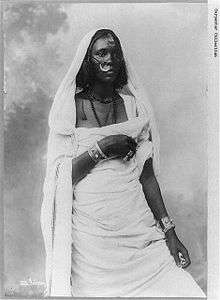
North Africa generally includes African countries with borders on the Mediterranean and northern Red Sea and Atlantic Ocean, bounded largely by the Sahara Desert to the south. Generally includes lands and countries north of the Sahara Desert. Due to ethnic, cultural and climatic characteristics, among others, it is a different region of the African continent, having close ties to Southwest Asia (Middle East).
- Afro-Asiatic peoples
- Haratin: A mixed Sub-Saharan African (from several peoples) and Berber or Arabic people that speaks either one of the Berber or Arabic languages: Morocco, Mauritania, Western Sahara, Algeria.
- Nilo-Saharan peoples
- Eastern Sudanic peoples
- Nubians: Egypt, Sudan, Middle Nile Valley
- Kadu peoples: Sudan, Nuba Hills
- Eastern Sudanic peoples
- Niger-Congo peoples
- Nuba: Sudan, Nuba Hills
- Katla-Rashad peoples: Sudan, Nuba Hills
- Talodi-Heiban peoples: Sudan, Nuba Hills
- Nuba: Sudan, Nuba Hills
Central Africa
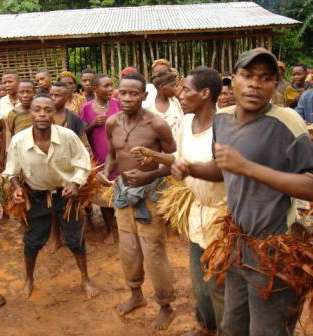
- Pygmy peoples:
- Bedzan: Northern Central Cameroon
- Mbenga:
- Mbuti (Bambuti):
- Twa
- Angola Twa: Northeastern, Eastern and Southern Angola
- Kasai Twa/Kuba Twa: Central Democratic Republic of Congo
- Mbote Twa: Southeastern Democratic Republic of Congo, Northwest of Lake Tanganyika
- Mongo Twa/Ntomba Twa: Western Democratic Republic of Congo, Lake Tumba, Lake Mai-Ndombe
- Upemba Twa/Luba Twa: Southeastern Democratic Republic of Congo, Upemba Depression
East Africa
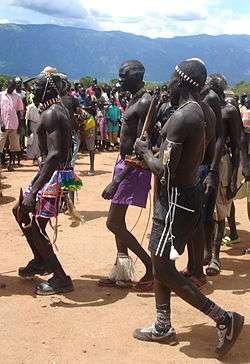
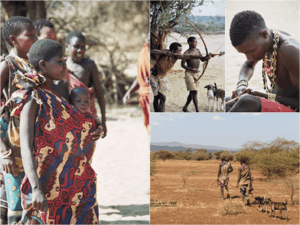
- Nilo-Saharan peoples
- Eastern Sudanic peoples
- Nilotic peoples
- Western Nilotic peoples
- Dinka-Nuer peoples
- Dinka (Jieng): mainly in Lakes, Warrap and Unity States, Upper Nile river course, Central and North South Sudan.
- Nuer (Naadh): mainly in Jonglei State, East of Upper Nile river course, East Central South Sudan.
- Luo peoples
- Anuak (Anywaa): mainly East Jonglei State, East South Sudan, and also mainly in Gambela Region, Lowlands of Far Southwest Ethiopia (border areas between South Sudan and Ethiopia).
- Shilluk (Chollo/Cøllø): mainly in North South Sudan, west of the Upper Nile river course, Upper Nile State, South Sudan (Kodok or Kothok, formerly known as Fashoda is in their territory).
- Dinka-Nuer peoples
- Western Nilotic peoples
- Surmic peoples
- South
- Southeast
- Surma
- Mursi (Mun): mainly in Debub Omo Zone, Southern Nations, Nationalities and Peoples Region, Southwest Ethiopia.
- Surma
- Southeast
- South
- Nilotic peoples
- Eastern Sudanic peoples
- Hadza (Hadzabe): Tanzania, Singida region: southeast, south and northwest of Lake Eyashi.
- Sandawe: Tanzania, Dodoma region: Kondoa district, between Bubu and Mponde rivers, Singida region.
- Pygmy peoples:
- Twa
- Bangweulu Twa: Northern Zambia, Bangweulu Swamps,
- Great Lakes Twa: Rwanda, Burundi, Uganda, Democratic Republic of Congo
- Kafwe Twa: Southern Zambia, Kafue Flats
- Lukanga Twa: Central Zambia, Lukanga Swamp
- Nsua: Western Uganda
- Twa
West Africa
- Afro-Asiatic peoples
- Niger-Congo peoples
- Benue-Congo peoples
- Cross River peoples
- Ijo peoples
- Ijaw/Ijo people: in the Niger delta region, southern Nigeria.
- Kwa peoples
- Potou-Tano peoples
- Senegambian peoples
- Fula-Serer peoples
- Serer (Sérère): Senegal, the Gambia, Mauritania, Western Sahara
- Fula-Serer peoples
- Volta-Niger peoples
- Benue-Congo peoples
- Nilo-Saharan peoples
Southern Africa
- Khoikhoi: Southern Africa, Kalahari Desert, Namibia, Botswana, South Africa
- Khoikhoi
- Nama (Namaqua): Namibia, Botswana, South Africa
- Damara
- Haiǁom
- Gǀu and Gǁana
- Naro
- Tsoa/Tshwa/Kua
- San: Kalahari Desert, Botswana/Namibia
- Kx'a/Ju–ǂHoan
- ǃKung/Juu
- ǂ’Amkoe
- ǂKxʼao-ǁʼae (Auen)
- ǃKung/Juu
- Tuu
- ǃKwi (!Ui)
- ǀXam
- ǂKhomani (Nǀu)
- Khwe (Khoi, Kxoe)
- Taa
- ǃXooŋake/Nǀumde
- ǃKwi (!Ui)
- Kx'a/Ju–ǂHoan
- Bantu peoples
Asia
Central Asia
- Indo-European peoples
- Iranian peoples
- East Iranian peoples
- Northeast Iranian peoples
- Pamiris (Pomir): Badakhshan (Afghanistan, Tajikistan), Pamir Mountains, Tashkurgan (in Xinjiang)
- Yaghnobi (Yaγnōbī́t): Tajikistan
- Northeast Iranian peoples
- East Iranian peoples
- Iranian peoples
- Mongolic peoples
- Sino-Tibetan peoples
- Turkic peoples
East Asia

- Ainu (Aynu): Hokkaido, Japan and (until the end of World War II) on Sakhalin Island, Russia
- Hmong-Mien peoples
- "Indigenous inhabitants": New Territories, Hong Kong
- Japonic peoples
- Ryukyuans: Ryūkyū Kingdom, now Japan
- Taiwanese aborigines: the island of Taiwan
- Turkic peoples
North Asia
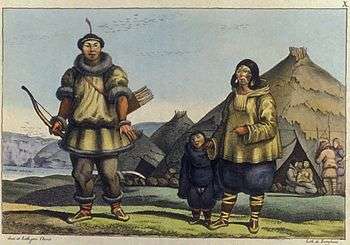

- Northern indigenous peoples of Russia: Over 40 distinct peoples, each with their own language and culture in the Asiatic part of Russia (Siberia).
- Chukchi-Kamchatkan peoples
- Chukotkan peoples
- Chukchi (Lyg'oravetl'et/O'ravetl'et/Ankalyn-Chavchu): Northeast Siberia, Russia
- Koryaks (Nymylan-Chauchuven): Russian Far East
- Chukotkan peoples
- Eskimo-Aleut peoples
- Yupik: Alaska and the Russian Far East
- Siberian Yupik (Yupighyt): Siberia, Russia, Alaska, United States.
- Yupik: Alaska and the Russian Far East
- Mongolic peoples
- Tungusic peoples
- Turkic peoples
- Northeast Turks
- Altayans (Altay-kishi): Titular nation of Altai Republic
- Khakas (Tadarlar):
- Tuvans (Tyvalar): Tuva Republic, close to the Altai Mountains
- Yakuts (Sakha): Yakutia, Siberia, Russia
- Northeast Turks
- Uralic peoples
- Finno-Ugric peoples
- Ugric peoples: Yugra, Western Siberia, Russia
- Khanty (Hantõ-Kantõk/Kantek/Khanti): Yugra, Western Siberia, Russia
- Mansi (Maan's'i/Maan's'i Maahum/Mansi), formerly known as Voguls: Yugra, Western Siberia, Russia
- Ugric peoples: Yugra, Western Siberia, Russia
- Samoyedic Peoples
- Northern Samoyedic peoples: West Siberia and Far Northern European Russia
- Enets (Entsi): Far Northern Western Siberia, Russia
- Nenets (Neney Neneche): Far Northern Western Siberia and Far Northern European Russia
- Nganasan (Ŋənəhsa(nəh)): Taymyr Peninsula, Siberia, Russia
- Northern Samoyedic peoples: West Siberia and Far Northern European Russia
- Yukaghirs (Odul/Vadul/Detkil'): Far Northern East Siberia, Russia
- Finno-Ugric peoples
- Yeniseian peoples
- Chukchi-Kamchatkan peoples
South Asia

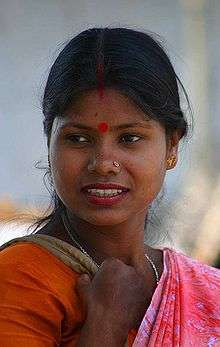
- Adivasi: collective term for many indigenous peoples in India (see also List of Scheduled Tribes in India)
- Austroasiatic peoples
- Dravidian peoples
- Badaga: Tamil Nadu, South India
- Gond: Gondwana Land, Central India
- Irula: Tamil Nadu, South India
- Kisan: indigenous peoples of the Orissa Sundergarh, Odisha, East India
- Kodava: Kodagu, Karnataka, South India
- Kota (Kothar/Kov): Tamil Nadu, South India
- Kuruba: Andhra Pradesh, Karnataka, Tamil Nadu, South India
- Toda: Tamil Nadu, South India
- Indo-European peoples
- Sino-Tibetan peoples
- Bodish peoples
- Bodo-Koch and Konyak peoples
- Bodo-Koch
- Konyak peoples
- Nocte: Tirap, Arunachal Pradesh, North-East India
- Kukish peoples
- Raji-Raute peoples
- Digaro peoples
- Jumma people (a collective term for several peoples)
- Indigenous peoples of Sikkim: India
- Dravidian peoples
- South Dravidian peoples
- Burusho: Hunza and Chitral districts, Gilgit-Baltistan, Northern Pakistan
- Indo-European peoples
- Indo-Aryan peoples
- Dard: Dardistan, Khyber-Pakhtunkhwa, Gilgit-Baltistan, Northern Pakistan
- Kalasha of Chitral (Kaĺaśa): Ancient pre-Muslim polytheistic pagan ethnic minority in Chitral District, Northern Pakistan
- Shina: Gilgit-Baltistan, Northern Pakistan
- Kashmiri Hindus: India
- Sindhi: Sindh, Pakistan, India
- Bengali: India, Bangladesh
- Gujarati: India
- Dard: Dardistan, Khyber-Pakhtunkhwa, Gilgit-Baltistan, Northern Pakistan
- Indo-Aryan peoples
- Sino-Tibetan peoples
- Lolo-Burmese peoples
- Burmish peoples
- Lolo-Burmese peoples
- Vedda (Wanniyala-Aetto): Sri Lanka
Southeast Asia



- Austroasiatic peoples
- Aslian peoples
- Senoi (Senoi/Sengoi/Sng'oi) (a people of the ethnic groups called by the generic word Orang Asli - Original People): in Peninsular Malaysia)
- Khmer Krom: of Vietnam
- Khmuic groups:
- Palaungic peoples
- Wa (Vāx): One of the hill tribes of Burma and China's Yunnan Province
- Aslian peoples
- Austronesian peoples
- Malayo-Polynesian peoples
- Chamic peoples
- Cham (Urang Campa): of Vietnam and Cambodia
- Proto-Malay (a people of the ethnic groups called by the generic word Orang Asli - Original People): in Peninsular Malaysia
- Moken (Moken) : in Burma, and Thailand
- Chamic peoples
- Malayo-Polynesian peoples
- Hmong-Mien peoples
- Montagnards (Degar): an umbrella term for several Pre-Vietnamese peoples that dwell in the plateaus and mountains of the southern regions of Vietnam
- Austroasiatic peoples
- Austronesian peoples
- Malayo-Polynesian peoples
- Negrito:
- Mani (Maniq): Far Southern Thailand
- Semang (a group of several peoples of the ethnic groups called by the generic word Orang Asli - Original People): in Peninsular Malaysia
- Sino-Tibetan peoples
- Karenic peoples
- Karen (Per Ploan Poe/Ploan/Pwa Ka Nyaw/Kanyaw): an alliance of hill tribes of Burma and Thailand
- Lolo-Burmese peoples
- Akha a.k.a. Aini or Aini-Akha: One of the hill tribes of Thailand, Laos, Burma and China's Yunnan Province
- Lahu (Ladhulsi/Kawzhawd): One of the hill tribes of Thailand, Burma, Laos and Yunnan.
- Lisu: One of the hill tribes of Burma, Thailand, Arunachal Pradesh, India & Yunnan and Sichuan, China
- Rakhine (Rəkhàin lùmjó): Arakan in Burma
- Yi (Nuosu/Nisu/Sani/Axi/Lolo): a group of several related peoples in Southern China, mainly in Yunnan Province.
- Karenic peoples
- Tai peoples: in China, Vietnam, Burma, Laos and Thailand
- Austroasiatic peoples
- Nicobarese people (Holchu): Nicobar Islands, India
- Austronesian peoples
- Malayo-Polynesian peoples
- Barito peoples
- Bajau (Sama/Samah/Samal): Borneo and the Sulu Archipelago (Malaysia, Indonesia, Philippines)
- Dayak: Borneo, (Malaysia and Indonesia)
- Malayic peoples
- North Bornean peoples
- Philippine peoples
- Igorot (Ifugao/Ipugao): Cordillera mountains in Luzon in the Philippines
- Lumad (Katawhang Lumad): Mindanao in the Philippines
- Mangyan: Mindoro in the Philippines
- Moro: Mindanao and Sulu archipelago in the Philippines
- Tribes of Palawan: Palawan, Philippines
- Barito peoples
- Malayo-Polynesian peoples
- Negrito:
- Aeta: Luzon, Philippines
- Andamanese, in the Andaman Islands, which include:
- Great Andamanese: formerly at least 10 distinct groups living throughout Great Andaman, now confined to a single community on Strait Island, Andaman Is.
- Jangil (Rutland Jarawa): now extinct, formerly of Rutland Island, Andamans
- Jarawa: South Andaman and Middle Andaman
- Onge (Önge): Little Andaman, Andaman Islands
- Sentinelese (?): North Sentinel Island, Andaman Islands
- Ati: Panay, Philippines
- Batak: Palawan, Philippines
- Pribumi (Native Indonesians): of Indonesia
Southwest Asia

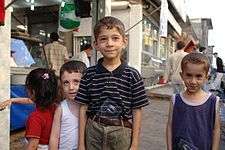

- Afro-Asiatic peoples
- Semitic peoples
- Central Semitic peoples
- Arabic peoples
- Druze (Al-Muwaḥḥidūn/Al-Muwaḥḥidīn/Ahl al-Tawḥīd): Jabal al-Druze, Far Southern Syria, Lebanon, Jordan, Israel
- Marsh Dwellers/Marsh Arabs (Ma'dan/ʻArab al-Ahwār): Arabic-speaking group in the Tigris-Euphrates marshlands of southern Iraq / Iranian border[8]
- Bedouin (badawī) of the interior deserts of Arabia and Syria.
- Northwest Semitic peoples
- Aramaeans (Āramayē): Central and Western Syria, ancient land of the Aramaeans (Aram) in the Levant, a Neo-Aramaic (Western Neo-Aramaic) speaking people that is indigenous and descends from ancient Aramaeans (in Antiquity Assyrians adopted their language and at present time they speak Assyrian Neo-Aramaic) (see Terms for Syriac Christians).
- Assyrians (Āṯūrāyē/Sūrāyē/Sūryāyē): A Christian neo-Aramaic speaking people indigenous to northern Iraq (which was once part of Assyria, Asuristan) in Mesopotamia), but have also traditionally lived in southeastern Turkey, northeast Syria and northwest of Iran.[9]
- Mandaeans (Mandeyānāye/Mandaʻnāye): Southern Mesopotamia (Southern Iraq) spoke a variety of Aramaic, practices a unique gnostic religion, Mandaeism.
- Canaanite peoples
- Hebrew peoples
- Jews (Yehudim): of the Judaean Mountains and surrounding areas. Jews, along with Samaritans, belong to the Israelite nation of the southern Levant, who are believed by archaeologists and historians to have branched out of the Canaanite peoples and culture through the development of a distinct monolatrous — and later monotheistic — religion centered on El/Yahweh,[10][11][12] one of the Ancient Canaanite deities. After the Romans destroyed Herod's Temple in 70 CE, and enslaved and exiled much of the remaining population in subsequent decades,[13] Jews have largely lived in the diaspora. Although only a small number of Jews managed to remain over the centuries as a result of persecution by the various conquerors of the region, many Jews returned from diaspora during the 19th and 20th centuries (mainly under the Zionist movement), as well as after the modern State of Israel was established in 1948. DNA studies show that all major diaspora Jewish communities, with the exception of Ethiopian and Yemenite Jews, derive the majority of their ancestry from the Levant (i.e. what is now Israel, Palestinian territories, Jordan, Syria, and Lebanon).[14]
- Samaritans (Samerim): of Samaria. An ethno-religious group of the Levant, closely related genetically and culturally to the Jewish diaspora and are understood to have branched off from the latter around the time of the Assyrian exile. Religiously, the Samaritans are adherents of Samaritanism, an Abrahamic religion closely related to Judaism. Their sole norm of religious observance is the Samaritan Pentateuch.[15][16]
- Hebrew peoples
- Arabic peoples
- South Semitic peoples
- Central Semitic peoples
- Semitic peoples
- Indo-European peoples
- Armenians (Hayer): The Christian Armenian people were the original inhabitants of what is now modern Eastern Turkey, specifically around Lake Van and the biblical mountain of Ararat and spoke the Western Armenian language. Since the Armenian Genocide in which up to 1,500,000 people perished, the number of the original Armenian inhabitants is almost non-existent and they have since been replaced with ethnic Turks and Kurds.
- Iranian peoples
- East Iranian peoples
- Northeast Iranian peoples
- Ossetians (Iræттæ): South Ossetia, Georgia, Southern Caucasus Mountains
- Northeast Iranian peoples
- West Iranian peoples
- Caspian/South Caspian peoples
- Gilaks: Gilan, North Iran, South Caspian Sea coast and Elburz Mountains
- Mazanderanis/Mazanis/Tabaris: Mazanderan, Tabaristan, Northern Iran, South Caspian Sea coast and Elburz Mountains
- Northwest Iranian peoples
- Northwestern I
- Kurds (Kurd/Kurmandzh): Kurdistan, Northwestern and Western Iran, Northern Iraq, Northeast and Northern Syria, Southeast Turkey, Zagros and East Anatolian Plateau
- Yazidis (Êzidî): Nineveh Province, Northern Iraq
- Lak people (Iran): Southwestern Iran, Zagros Mountains
- Zaza-Gorani peoples
- Shabaks: Sinjar District of the Nineveh Province in northern Iraq.
- Zazas: Southeastern Turkey, Upper Euphrates river, East Anatolian Plateau
- Kurds (Kurd/Kurmandzh): Kurdistan, Northwestern and Western Iran, Northern Iraq, Northeast and Northern Syria, Southeast Turkey, Zagros and East Anatolian Plateau
- Northwestern II
- Baluchis (Baloch/Baluch): Baluchistan, Southeastern Iran, Southwestern Pakistan, Extreme Southern Afghanistan
- Tatic peoples
- Talysh (Talyshon): Northwestern Iran, Far South Azerbaijan, South Caspian Sea coast and Elburz Mountains
- Tats (Iran)/South Tats (Irünə Tâtün): Northwest Iran
- Northwestern I
- Southwest Iranian peoples
- Larestani–Gulf peoples
- Lurs and Bakhtiaris
- Persian peoples
- Aimaqs (Aymāq): West Central Afghanistan, Western Hindu-Kush
- Hazara: a mixed Mongol and Iranian people that speaks an Iranian language (Hazaragi) in Central Afghanistan, Central Hindu Kush Mountains.
- Tats (Caucasus): East Caucasus Mountains, Azerbaijan
- Caspian/South Caspian peoples
- East Iranian peoples
Caucasus
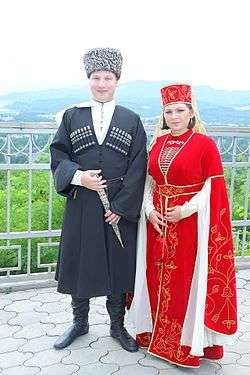
- Indo-European peoples
- Armenians (Hayer):
- Iranian peoples
- East Iranian peoples
- Northeast Iranian peoples
- Ossetians (Iræттæ): North Ossetia, a Republic of Russia, and South Ossetia, a De Jure autonomous region of Georgia (Sakartvelo), self-proclaimed sovereign country, North and South slopes of Central Caucasus Mountains.
- Northeast Iranian peoples
- West Iranian peoples
- Southwest Iranian peoples
- Persian peoples
- Tats (Caucasus): East Caucasus Mountains, Azerbaijan
- Persian peoples
- Southwest Iranian peoples
- East Iranian peoples
- Kartvelian peoples
- Northeast Caucasian peoples
- Avar-Andic peoples
- Avar people (Caucasus) (Magharulal/Avaral): Dagestan, European Russia, Northern Caucasus Mountains
- Andic peoples
- Dargins (Darganti): Dagestan, European Russia, Northern Caucasus Mountains
- Khinalug (Kettiturdur/Kayttiodur/Ketid/Ketsh Khalkh)
- Lak people (Dagestan) (Lak): Dagestan, European Russia, Northern Caucasus Mountains
- Lezgic peoples
- Aghul (Agular): Dagestan, European Russia, Northern Caucasus Mountains
- Archins (Arshishttib)
- Budukh (Budad)
- Jeks (Cekad/Dzhekad)
- Kryts (Kh'rytsha'/Kyrtuar)
- Lezgians (Lezgiyar/Leqer): Dagestan, European Russia, Northern Caucasus Mountains
- Rutul (Mykhabyr): Dagestan, European Russia, Northern Caucasus Mountains
- Tabasarans: Dagestan, European Russia, Northern Caucasus Mountains
- Tsakhur (Yiqby): Azerbaijan, Southern Caucasus Mountains
- Udins (Udi/Uti): Northern Azerbaijan, Southern Caucasus Mountains
- Nakh peoples
- Bats (Batsbi)
- Vainakh peoples
- Chechens (Nokhchiy): Chechenia, European Russia, Northern Caucasus Mountains
- Ingush (Ghalghay): Ingushetia, European Russia, Northern Caucasus Mountains
- Tsezic (Didoic) peoples
- Avar-Andic peoples
- Northwest Caucasian peoples
- Abkhaz-Abaza peoples
- Abazins (Abaza)
- Abkhazians (Aphsua): Abkhazia (Aphsny) - a De Jure autonomous region of Georgia (Sakartvelo), self-proclaimed sovereign country.
- Circassian peoples
- West Circassian peoples
- Adyghe (Adyge): Adyghe Republic, European Russia, Northern Caucasus Mountains
- East Circassian peoples
- Cherkess (Cherkes): Karachay-Cherkessia, European Russia, Northern Caucasus Mountains
- Kabardians (Qeberdeykher): Kabardino-Balkaria, European Russia, Northern Caucasus Mountains
- West Circassian peoples
- Ubykh (Tʷaχ): were indigenous to the mountains of West Caucasus, Sochi area, Krasnodar Krai, Russia, later migrated to Turkey.
- Abkhaz-Abaza peoples
Europe
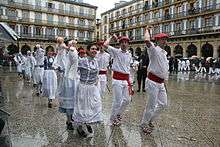
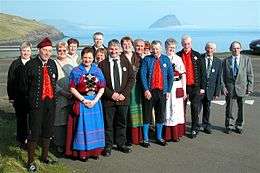
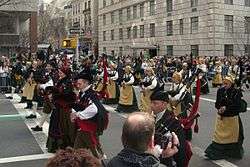
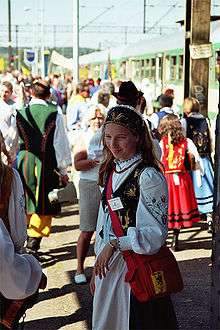
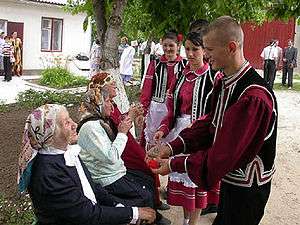

- Basques (Euskaldunak): Northern Spain and Southern France, Western Pyrenees Mountains
- Indo-European peoples
- Celtic peoples
- Insular Celtic peoples
- Goidelic peoples
- Manx (Ny Manninee): Isle of Man, Irish Sea/Manx Sea, Northwestern part of Great Britain
- Brythonic peoples
- Bretons (Bretoned/Breizhiz): Brittany peninsula, Western France
- Cornish (Kernowyon): Cornwall peninsula, England, United Kingdom
- Welsh (Cymry): Wales, Western United Kingdom, who along with the Cornish, form the Brythonic peoples, the natives of the entire of the island of Great Britain, descendents of the original settlers of the British Isles.[17]
- Goidelic peoples
- Insular Celtic peoples
- Germanic peoples
- North Germanic peoples
- East Scandinavian peoples
- West Scandinavian peoples
- West Germanic peoples
- Swabians: Swabia, Germany.
- Anglo-Frisian peoples
- Frisians (Friezen): Historic Frisia, Northeastern Netherlands, Northwestern Germany
- North Germanic peoples
- Iranian peoples
- East Iranian peoples
- Northeast Iranian peoples
- Ossetians (Iræттæ): North Ossetia, Russia, Northern Caucasus Mountains slope
- Jasz (Jassy/Iasi): Jaszsag, North Central Hungary
- Northeast Iranian peoples
- East Iranian peoples
- Latin peoples/Romance peoples
- Italics: Italy, progenitors of the modern day Romance peoples, as well as a whole plethora of now extinct tribes.
- Latins: Italy.
- Continental Latin peoples
- East Latin peoples
- Aromanians (Rrãmãnji/Armãnji): Southern Balkans, Northern and Central Greece, Republic of Macedonia, Southern Albania, Southwestern Bulgaria
- Corsicans (Corsi): Corsica, France
- Istro-Romanians (Rumeni/Rumâri/Rumêri/Vlaşi): Inland East Istria, Croatia
- Megleno-Romanians (Vlaşi/Rumâri): Areas of the border of between Northern Greece (Macedonia) and Republic of Macedonia
- West Latin peoples
- Andalusians (Andaluces): Andalucia, Southern part of Spain
- Aragonese (Aragoneses): Aragon, Northeast Spain
- Asturians (Asturianos): Asturias, Northern Spain
- Catalans (Catalans): Catalonia, Valencian Community, Balearic Islands (Paisos Catalans), Eastern Spain
- Canarians (Canarios): Canary Islands, Spain
- Friulians (Furlans): Friul, Northeastern Italy
- Galicians (Galegos): Galicia, Northwestern Spain
- Ladins (Ladins): South Tyrol, Trentino, Province of Belluno, Italy
- Leonese (Llïoneses): Leon, Northwestern Spain
- Mirandese (Mirandeses): Miranda do Douro Municipality, Far Eastern Bragança District, Far Eastern Trás-os-Montes e Alto Douro Province, Far Northeastern Portugal
- Occitans (Occitans): Occitania, Southern part of France
- Romansh: Graubünden (Grisons), Switzerland
- East Latin peoples
- Insular Latin peoples
- Slavic peoples
- Celtic peoples
- Turkic peoples
- Common Turks
- Kipchak Turks
- Bashkirs (Başqorttar): Bashkir Republic, European Russia
- Crimean Karaites (Qrymqaraylar): Crimean Peninsula in Southern Ukraine
- Crimean Tatars (Qırımtatarlar): Crimean Peninsula in Southern Ukraine
- Volga Tatars (Tatarlar): Tatarstan, European Russia
- Oghuz Turks
- Kipchak Turks
- Oghur Turks
- Common Turks
- Uralic peoples
- Finno-Ugric peoples
- Finnic peoples
- Baltic Finns
- Izhorians (Ižoralaizet/Inkeroine/Izhora/Izhoralaine/Karjalain/Maaväki): Northwest of Russia
- Karelians (Karjalaižet): Northwest of Russia
- Livonians (Raandalist/Kalamied/Liivõd/Liibõd/Liivnikad/Liivlist): Far Northern Courland peninsula, Latvia
- Setos (Setokõsõq): Setomaa - Far Southeastern Estonia, southern border region between Estonia and Russia, East Võru County and Northwest Pskov Oblast, southwest of Chudskoye-Pskov/Peipus Lake.
- Veps (Vepslaine/Bepslaane/Lüdinik/Lüdilaine): Republic of Karelia, Northwest of Russia
- Permians
- Komi (Komiyas): Komi Republic in Northeast of European Russia
- Udmurts (Udmurt'yos): Udmurt Republic in Northeast of European Russia
- Sami: Northern and central Norway, Sweden, Finland and Kola peninsula in the Northwest of Russia
- Volga Finns
- Baltic Finns
- Finnic peoples
- Samoyedic peoples
- North Samoyedic peoples
- Nenets (Neney Neneche) : Northeastern part of European Russia
- North Samoyedic peoples
- Finno-Ugric peoples
Oceania
Oceania includes most islands of the Pacific Ocean, New Guinea and the continent of Australia.
List of peoples by geographical and ethnolinguistic grouping:
Australia
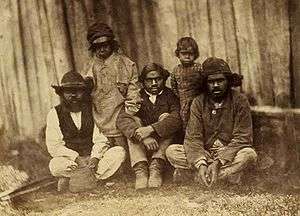
Australia includes the continental landmass, and associated islands.
- Indigenous Australians: Australia
- Australian Aborigines
- Yolngu: Arnhem Land, Australia
- Spinifex people: Great Victorian Desert, Western Australia, Australia.
- Pintupi: Western Australia, Australia
- Djabugay: Cairns region, Queensland, Australia
- Tiwi: Tiwi Islands, Northern Territory, Australia
- Torres Strait Islanders: Torres Strait, Australia
- Palawa (Aboriginal Tasmanians): Tasmania, Australia
- Australian Aborigines
Melanesia

Melanesia generally includes New Guinea and other (far-)western Pacific islands from the Arafura Sea out to Fiji. The region is mostly inhabited by the Melanesian peoples.
- Melanesians
- Austronesian speaking Melanesians
- Papuan speaking Melanesians
- Papuans: more than 250 distinct tribes or clans, each with their own language and culture. The main island of New Guinea and surrounding islands (territory forming independent state of Papua New Guinea (PNG) and the Indonesian provinces of West Papua and Papua. Considered "Indigenous" these people are a subject to many debates.
- Sepik peoples
- Kwoma: Peilungua Mountains, Papua New Guinea.
- Iatmul: Sepik, Papua New Guinea.
- Sepik Hill
- Sanio
- Hewa: Southern Highlands, PNG
- Sanio
- Trans New-Guinean peoples
- Huli of the Southern Highlands, Papua New Guinea.
- Angu: Southwestern Morobe Province, Papua New Guinea.
- Bosavi
- Kaluli-Kasua
- Kaluli: Great Papuan Plateau, PNG
- Kaluli-Kasua
- Ok
- Mountain Ok
- Wopkaimin: western PNG, Star Mountains.
- Mountain Ok
- West Trans New-Guinean peoples
- Dani: Papua, Indonesia
- Korowai: West Papua, close to the Papua New Guinea border.
- Asmat: Asmat Regency, West Papua.
- Sepik peoples
Micronesia
Micronesia generally includes the various small island chains of the western and central Pacific. The region is mostly inhabited by the Micronesian peoples.
- Micronesian peoples
Polynesia
Polynesia includes New Zealand and the islands of the central and southern Pacific Ocean. The region is mostly inhabited by the Polynesian peoples.
- Polynesians
- Ellicean–Outlier
- Futunic
- Marquesic
- Kanaka Maoli: Hawaii, United States
- Marquesan and Mangarevan
- Rapanui: Easter Island (Rapanui)
- Samoic
- Tahitic
- Tongic
- Polynesians
- Ellicean–Outlier
- Futunic
- Anuta: Solomon Islands
- Fagauvea: Ouvéa (New Caledonia)
- Futuna and Aniwa: Vanuatu
- Emae: Vanuatu
- Makata: Vanuatu
- Mele (Erakoro, Eratapu): Vanuatu
- Rennel and Bellona: Solomon Islands
- Tikopia: Solomon Islands
- Vaeakau-Taumako: Solomon Islands
The Americas
The Americas is the supercontinent comprising North and South America, and associated islands.
List of peoples by geographical and ethnolinguistic grouping:
North America
North America includes all of the continent and islands east of the Bering Strait and north of the Isthmus of Panama; it includes Greenland, Canada, United States, Mexico, Central American and Caribbean countries. However a distinction can be made between a broader North America and a narrower Northern America and Middle America due to ethnic and cultural characteristics.
- Indigenous peoples in North America by Country
- Indigenous peoples in North America by native cultural regions
Arctic
- Eskimo–Aleut
- Aleut (Unangax): Aleutian Islands and Kamchatka Krai
- Eskimo/Yupit-Inuit
- Yupik: Alaska, United States
- Inuit peoples: Canadian Arctic - Northwest Territories, Nunavik, Nunatsiavut, Nunavut; Greenland; Alaska, United States
- Greenlandic Inuit: Greenland
- Inupiat (Iñupiat): Alaska's Arctic, North Slope and boroughs and the Bering Strait
- Inuit proper (Inuit): Canadian Arctic
- Eastern Canadian Inuit: East Canadian Arctic, East Nunavut, Nunavik, Nunatsiavut
- Western Canadian Inuit (Inuvialuit): West Canadian Arctic, Inuvialuit Settlement Region, Arctic coast of Northwest Territories, West Nunavut
- Métis: a mixed First Nations (from several peoples) and European (from several peoples) people of Canada.
Subarctic
- Na-Dené peoples
- Athabaskan peoples
- Northern Athabaskan peoples
- Dene of Yukon, British Columbia, Manitoba, Northwest Territory, and Alberta, Canada.
- Alaskan Athabaskans
- Southern Alaskan peoples
- Koyukon of Interior Alaska.
- Kutchin of Interior Alaska and the Yukon.
- Tanana Athabaskans.
- Kolchan of Interior Alaska.
- Deg Hit'an of Interior Alaska.
- Dena'ina of Interior Alaska.
- Holikachuk
- Hän of Yukon, Canada, and Alaska, United States.
- Northern Athabaskan peoples
- Athabaskan peoples
- Métis: a mixed Native American (from several peoples) and European (from several peoples) people of Canada.
- Algonquians
- Cree of Montana, United States, and Manitoba, Alberta, and Saskatchewan, Canada.
- Innu of Northeastern Quebec, and Western Labrador, Canada.
- Annishinabe of Quebec, Ontario, and Manitoba, Canada, as well as Kansas, Michigan, Minnesota, Oklahoma, and Wisconsin, United States.
- Beothuk of Newfoundland, Canada.
Pacific Northwest Coast
- Makah of Washington, United States.
- Quinalt of Washington, United States.
- Nootka of British Columbia, Canada.
- Kwakiutl of British Columbia, Canada.
- Eyak of Alaska, United States.
- Haida of British Columbia, Canada, and Alaska, United States.
- Tlingit of Alaska, United States.
- Tshimshian of British Columbia, Canada, and Alaska, United States.
Northwest Plateau
Great Plains
- Comanche of Texas and Oklahoma, United States.
- Osage of Kansas and Nebraska, United States.
- Sioux of North Dakota, South Dakota, and Minnesota, United States, as well as Saskatchewan, and Alberta, Canada.
- Lakota of South Dakota, United States.
- Dakota people of Minnesota, United States, and Saskatchewan, Canada.
- Kiowa of Texas, and Oklahoma.
- Plains Apache (see the Southwest section for another category this tribe belongs too) of Texas, and Oklahoma.
- Crow of Montana.
- Omaha of Nebraska.
- Blackfoot of Montana, United States, and Saskatchewan, Canada.
Eastern Woodlands
- Indigenous peoples of the Northeastern Woodlands
- Iroquoian peoples
- Haudenosaunee of New York, Wisconsin, and Oklahoma, United States, as well as Quebec and Ontario, Canada.
- Mohawk of Quebec, Canada, and New York, United States.
- Seneca of New York, and Oklahoma, United States, as well as Ontario, Canada.
- Cayuga of Oklahoma, and New York, United States, as well as Ontario, Canada.
- Oneida of Wisconsin and New York, United States, as well as Ontario, Canada.
- Tuscarora of New York, United States, and Ontario, Canada.
- Onondaga of New York, United States, and Ontario, Canada.
- Wyandot of Kansas, Michigan, and Oklahoma, United States, as well as Ontario, Canada.
- Nation du chat of Upstate New York, Ohio, and Northwest Pennsylvania, United States.
- Susquehannock of Pennsylvania, and West Virginia, United States.
- St. Lawrence Iroquoians: St. Lawrence River, Quebec, Canada, and New York, United States.
- Monongahela: Pennsylvania, West Virginia, and Ohio, United States.
- Nottoway of Virginia, United States.
- Westo of Virginia and South Carolina, United States.
- Haudenosaunee of New York, Wisconsin, and Oklahoma, United States, as well as Quebec and Ontario, Canada.
- Algic peoples
- Algonquian peoples
- Chowanoke of North Carolina.
- Carolina Algonquian
- Powhatan Confederacy of Virginia.
- Wampanoag of Massachusetts.
- Wabanaki of Maine, United States, and New Brunswick and Newfoundland, Canada.
- Abenaki of New Hampshire and Maine.
- Penobscot of Maine.
- Miqmac of New Brunswick, and Newfoundland.
- Passamaquoddy of Maine, United States, and New Brunswick, Canada.
- Maliseet of New Brunswick and Quebec.
- Shawnee of the Ohio River Valley, now Oklahoma.
- Central Algonquian peoples
- Kikapú (Kiikaapoa/Kiikaapoi): indigenous from southeast Michigan, United States, also in Coahuila, Mexico
- Annishinabe
- Ojibwe of Minnesota, North Dakota, and Michigan, United States, as well as Ontario, Canada.
- Potawatomi of Michigan and Indiana, United States, as well as Ontario, Canada.
- Odawa of Oklahoma and Michigan, United States, as well as Ontario, Canada.
- Cree of Alberta, Manitoba, Ontario, Saskatchewan, and the Northwest Territories, Canada, as well as Montana, United States.
- Algonquian peoples
- Iroquoian peoples
- Indigenous peoples of the Southeastern Woodlands
- Muskogeans
- Indigenous peoples of Florida
- Siouans
- Ho-Chunk of Wisconsin and Michigan.
- Catawba of North Carolina.
- Pee Dee of South Carolina.
- Caddoans
- Caddo of Texas, Arkansas, and Louisiana.
- Pawnee of Oklahoma and Arkansas, United States.
- Southern Plains villagers of Western Oklahoma, Texas, Kansas, and Southeastern Colorado.
- Arikara of North Dakota, United States.
- Hidatsa of North Dakota, United States.
- Wichita of Oklahoma, Kansas, and Texas, United States.
California
- Yuman-Cochimi peoples
- Cochimí people: Baja California, Mexico
- Core Yuman peoples
- Kiliwa (K'olew): Baja California, Mexico
- Paipai (Akwa'ala/Yakakwal): Baja California, Mexico
- Delta-Californian peoples
- Miwok of California, United States.
- Maidu of California, United States.
- Wintu of California, United States
- Chumash of California, United States.
- Tongva of California, United States.
- Modoc of California, and Oregon, United States.
- Athabaskans
- Achumawi of California, and Oregon, United States.
- Hupa of California and Oregon, United States.
- Cahuilla of California, United States.
- Mojave of California, and Nevada, United States.
- Uto-Aztecans
- Mono of California, and Nevada, United States.
- Northern Paiute of California and Nevada, United States.
- Ohlone of California, United States.
- Karok of California, United States.
Great Basin
- Ute of Utah, United States.
- Shoshone of Colorado, Nevada, and Utah, United States.
- Mono of California, United States.
- Bannock of Idaho, United States.
- Western Shoshone of Nevada, United States.
- Timbisha of Nevada, United States.
- Washoe of Nevada, United States.
- Paiute of Colorado, California, Nevada, and Utah, United States.
- Pais of Colorado, Arizona, and New Mexico, United States, as well as Baja California, Mexico.
- Hualapai of Arizona, United States.
- Walapai of Arizona and Colorado, United States.
Southwest
- Uto-Aztecan peoples
- Aztecan (Nahuan) peoples
- Cáhitan peoples
- Tarahumaran peoples
- Guarijío: Sonora, Mexico
- Tarahumara (Rarámuri-Omugí): Chihuahua and Durango, Mexico
- Tepiman peoples
- Seri (Comcaac): Sonora, Mexico
- Puebloan peoples: Colorado, New Mexico, Arizona, Utah, and Texas, United States
- Hopi of New Mexico, United States.
- Zuni of Arizona, United States.
- Anasazi of New Mexico and Colorado, United States.
- Tiwa of New Mexico, United States.
- Mogollon of New Mexico, Arizona, United States, and Sonora, Mexico.
- Hohokam of Southern Arizona, United States.
- Southern Athabascans
- Apache of Chihuahua, Coahuilla, and Sonora, Mexico, as well as Arizona, New Mexico, Oklahoma, and Texas, United States.
- Chiricahua of Southern New Mexico, Northern Mexico, and Southeast Arizona.
- Lipan Apache of Northern Texas, and Western Oklahoma.
- Plains Apache of Oklahoma.
- Mescalero of Arizona, New Mexico, and Northern Chihuahua.
- Western Apache of Western Arizona.
- Navajo of the Four Corners region.
- Apache of Chihuahua, Coahuilla, and Sonora, Mexico, as well as Arizona, New Mexico, Oklahoma, and Texas, United States.
- O'odham of Sonora, Mexico, and Arizona, United States.
- Pima of Arizona, United States.
- Papago of far Northern Sonora, Mexico, and Southern Arizona, United States.
Mesoamerica


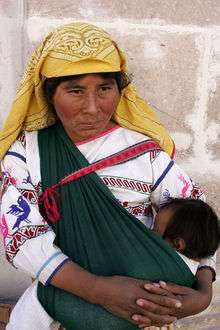
- Huave (Ikoots/Kunajts): Oaxaca, Mexico
- Lenca: Honduras and El Salvador
- Maya peoples
- Ch'olan peoples
- Huastec (Téenek/Te' Inik): San Luis Potosí, Mexico
- Mamean peoples
- Q'anjobalan peoples
- Qichean peoples
- Yucatecan peoples
- Itza: Guatemala
- Lacandón (Hach Winik): Chiapas, Mexico
- Mopan: Guatemala and Belize
- Yucatec Maya (Maya proper) (Màaya): Yucatán, Quintana Roo and Campeche, Mexico
- Mixe-Zoquean peoples
- Oto-Manguean peoples
- Tarascan (P'urhépecha): Michoacán, Mexico
- Tequistlatecan/Chontal de Oaxaca: Oaxaca, Mexico
- Totonacan peoples
- Uto-Aztecan peoples
- Xinca (Xinka): Guatemala
North American Circum-Caribbean
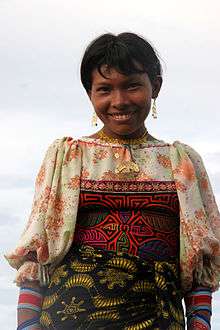
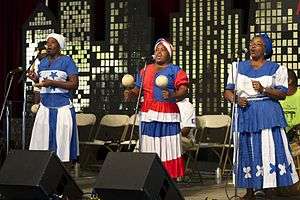
- Chibchan peoples
- Chocó/Embera-Wounaan peoples
- Misumalpan peoples
- Tolupan/Jicaque: Honduras
- Zambo/Cafuso peoples (mixed Sub-Saharan African and Amerindian peoples)
- Garífuna: A mixed Sub-Saharan African (from several peoples) and Amerindian people (mainly from the Island Caribs - Kalhíphona) that traditionally speaks an Arawakan language in Belize and Honduras.
- Miskito Sambu: A mixed Sub-Saharan African (from several peoples) and Amerindian people (mainly from the original Miskito) that traditionally speaks Miskito, a Misumalpan language, and also Nicaragua Creole English in Nicaragua and Honduras.
- Black Seminoles: Florida, The Bahamas, and Mexico. (Mixed Seminole and African-American).
Caribbean

The Caribbean, or West Indies, generally includes the island chains of the Caribbean.
- Arawakan peoples
- Northern
- Circum-Caribbean/Ta-Arawakan peoples
- Eyeri/Igneri: Lesser Antilles. An Arawak people, may have been the Kalinago/Island Caribs before caribbeanization. (The Island Caribs had the tradition that the Igneri were the older people of Lesser Antilles but they could have been ancestors of the majority of Island Caribs).
- Island Caribs (Carib/Kalinago/Kalhíphona): Lesser Antilles. Often called "Island Caribs" (but may have been an older arawak people with a carib conquering warrior elite or influenced by Mainland Caribs. Apparently, the majority of the people spoke an arawakan language and not a carib one.)
- Taíno: Amerindians who originally inhabited the Greater Antilles of the Caribbean, they are of Arawakan descent.
- Neo-Taíno nations Some scholars distinguish between the Taíno and Neo-Taíno groups. Neo-Taíno groups were also Amerindians of the Antilles islands, but had distinctive languages and cultural practices that differed from the High Taíno.[18] These groups include:
- Ciboney: a term preferred in Cuban historical texts for the neo-Taino-Siboney nations of the island of Cuba.
- Ciguayo: Eastern Hispaniola
- Lucayans: Based in the Bahamas.
- Macorix: Hispaniola.
- Neo-Taíno nations Some scholars distinguish between the Taíno and Neo-Taíno groups. Neo-Taíno groups were also Amerindians of the Antilles islands, but had distinctive languages and cultural practices that differed from the High Taíno.[18] These groups include:
- Circum-Caribbean/Ta-Arawakan peoples
- Northern
- Guanahatabey people: Western Cuba island, a Pre-Arawakan and Pre-Island Carib people of the Caribbean Islands.
South America
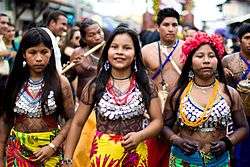


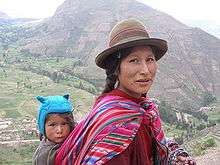
South America generally includes all of the continent and islands south of the Isthmus of Panama.
- Indigenous peoples in South America by Country:
- Indigenous peoples in South America by native cultural regions
South American Circum-Caribbean
- Arawakan peoples
- Northern
- Chibchan peoples
- Chocoan peoples
- Warao: Venezuela's Orinoco River delta region.
Guianas
Amazon
- Arawakan peoples
- Barbacoan peoples
- Awan
- Awá-Kwaiker: Northern Ecuador
- Awan
- Bora-Witoto peoples
- Cahuapanan peoples
- Jivaroan (Shuar): Loreto and San Martín, Peru
- Nukak: Colombia
- Panoan peoples
- Ticuna-Yuri peoples
- Tucanoan peoples
- Tupian peoples
- Urarina (Kachá): Chambira Basin, Loreto Peru
- Yanomami (Yanõmami/Yanõmami Thëpë): Venezuela/Brazil
Eastern Highlands
- Charruan peoples
- Macro-Gê peoples
- Tupian peoples
- Tupí-Guaraní
Gran Chaco
Andes
- Aymaran peoples
- Nasa: Colombia
- Quechuan peoples
Southern Cone
- Alacalufe (Kawésqar): Far Southern Chile
- Araucanian peoples
- Yaghan (Yámana): Far Southern Chile
- Fuegans of Tierra del Fuego, divided by Chile and Argentina.
Circumpolar
Circumpolar peoples is an umbrella term for the various indigenous peoples of the Arctic. List of peoples by ethnolinguistic grouping:
- "Paleosiberian"
- Eskimo–Aleut
- Aleut (Unangax): Aleutian Islands and Kamchatka Krai
- Eskimo/Yupik-Inuit
- Yupik: Alaska, United States and the Russian Far East, Siberia
- Alutiiq (Sugpiat): Alaska, United States
- Central Alaskan Yup'ik (Yupiat/Yupiit): Alaska, United States
- Cupik (Cupiit): Alaska, United States
- Siberian Yupik (Yupighyt): Siberia, Russia
- Inuit: Greenland, Northern Canada (Nunavut and Northwest Territories), Alaska, United States
- Inupiat (Iñupiat): Alaska's Arctic and North Slope boroughs and the Bering Straits
- Kalaallit (Kalaallit): Greenland
- Yupik: Alaska, United States and the Russian Far East, Siberia
- Turkic
- Uralic
- Finno-Ugric
- Samoyedic peoples
- Northern Samoyedic peoples: West Siberia and Far Northern European Russia
- Enets (Entsi): Far Northern Western Siberia, Russia
- Nenets (Neney Neneche): Far Northern Western Siberia and Far Northern European Russia
- Nganasan (Ŋənəhsa(nəh)): Taymyr Peninsula, Siberia, Russia
- Northern Samoyedic peoples: West Siberia and Far Northern European Russia
- Yukaghirs (Odul/Vadul/Detkil'): Far Northern East Siberia, Russia
See also
- List of contemporary ethnic groups
- Lists of people by nationality
- List of indigenous rights organizations
See also
| Wikimedia Commons has media related to Indigenous people. |
| Wikisource has original text related to this article: |
| Wikisource has original text related to this article: |
- Center for World Indigenous Studies
- Declaration on the Rights of Indigenous Peoples
- Definitions and identity of indigenous peoples
- Indigenous archaeology
- Indigenous Dialogues
- Indigenous (ecology)
- Indigenous intellectual property
- Indigenous knowledge
- Indigenous language
- Indigenous medicine
- Indigenous music
- International Work Group for Indigenous Affairs
- United Nations Permanent Forum on Indigenous Issues
- World Council of Indigenous Peoples
- Working Group on Indigenous Populations
- See all pages that start with indigenous people or indigenous
Notes
- ↑ Sanders, Douglas (1999). "Indigenous peoples: Issues of definition". International Journal of Cultural Property. 8 (1): 4–13. doi:10.1017/S0940739199770591.
- ↑ Ritzer, G., and Ryan, M.J., eds., The Concise Encyclopedia of Sociology, Wiley, 2011, p.313
- ↑ Alia, V., Names and Nunavut: Culture and Identity in Arctic Canada, Berghahn Books, 2008, p.143
- ↑ Jose R. Martinez Cobo
- ↑ Definition of indigenous peoples
- ↑ "World Directory of Minorities and Indigenous Peoples – Philippines: Overview, 2007", UNHCR | Refworld.
- ↑ Hanihara, T (1992). "Negritos, Australian Aborigines, and the proto-sundadont dental pattern: The basic populations in East Asia". American Journal of Physical Anthropology. 88 (2): 183–96. doi:10.1002/ajpa.1330880206. PMID 1605316.
- ↑ Sawahla & Dloomy (2007, pp. 425–433)
- ↑ Unrepresented Nations and People Organization | UNPO, Assyrians the Indigenous People of Iraq
- ↑ Tubb, 1998. pg-13-14.
- ↑ Mark Smith in "The Early History of God: Yahweh and Other Deities of Ancient Israel" states "Despite the long regnant model that the Canaanites and Israelites were people of fundamentally different culture, archaeological data now casts doubt on this view. The material culture of the region exhibits numerous common points between Israelites and Canaanites in the Iron I period (c. 1200 – 1000 BC). The record would suggest that the Israelite culture largely overlapped with and derived from Canaanite culture... In short, Israelite culture was largely Canaanite in nature. Given the information available, one cannot maintain a radical cultural separation between Canaanites and Israelites for the Iron I period." (pp. 6–7). Smith, Mark (2002) "The Early History of God: Yahweh and Other Deities of Ancient Israel" (Eerdman's)
- ↑ Rendsberg, Gary (2008). "Israel without the Bible". In Frederick E. Greenspahn. The Hebrew Bible: New Insights and Scholarship. NYU Press, pp. 3–5
- ↑ Josephus. War of the Jews 9:2.
- ↑ http://www.khazaria.com/genetics/abstracts.html
- ↑ The UN Refugee Agency | UNHCR, World Directory of Minorities and Indigenous Peoples
- ↑ Department of Evolutionary Biology at University of Tartu Estonian Biocentre | Reconstruction of Patrilineages and Matrilineages of Samaritans and Other Israeli Populations From Y-Chromosome and Mitochondrial DNA Sequence Variation, Molecular Anthropology Group
- ↑
- ↑ Rouse (1992)
References
- Kipuri, Naomi (2007), "Kenya", in Sille Stidsen (compilation and ed.), The Indigenous World 2007 (PDF online edition), International Work Group for Indigenous Affairs yearbooks (ISSN 1024-0217), Marianne Wiben Jensen (Horn of Africa and East Africa regional ed.), Copenhagen: IWGIA, distributed by Transaction Publishers, pp. 468–476, ISBN 978-87-91563-23-2, OCLC 30981676
- Minority Rights Group International (1997), World Directory of Minorities, London, UK: Minority Rights Group International, ISBN 978-1-873194-36-2
- Rouse, Irving (1992), The Tainos: Rise and Decline of the People who greeted Columbus, New Haven, Connecticut: Yale University Press, ISBN 0-300-05181-6, OCLC 24469325
- Tubb, Jonathan N. (1998). Canaanites. University of Oklahoma Press. ISBN 0-8061-3108-X.
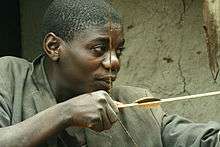
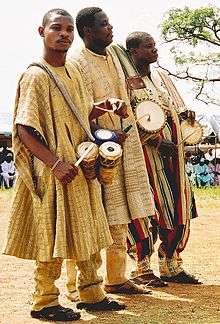
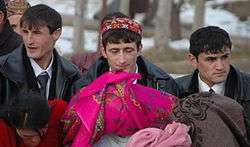
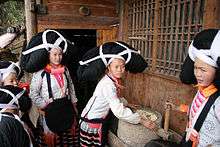
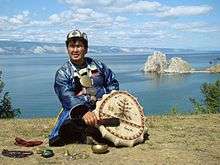
%2C_2010_by_Biplob_Rahman.jpg)

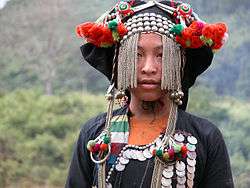
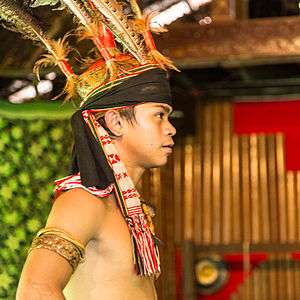
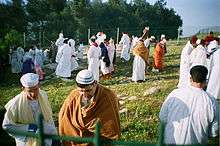
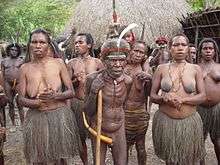


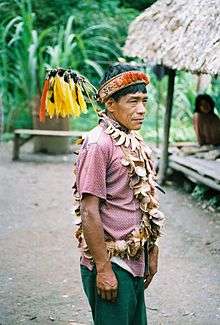
.svg.png)
.svg.png)
.svg.png)
.svg.png)
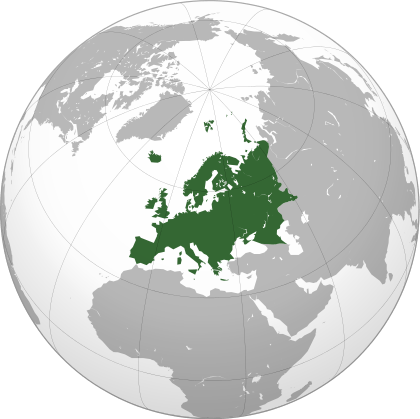

.svg.png)
.svg.png)
.svg.png)
.svg.png)
.svg.png)